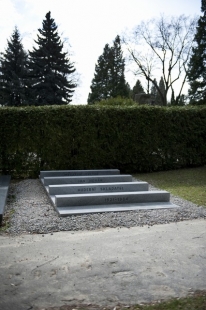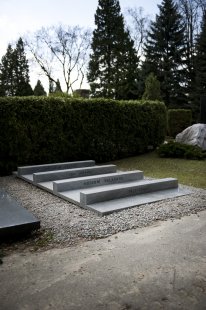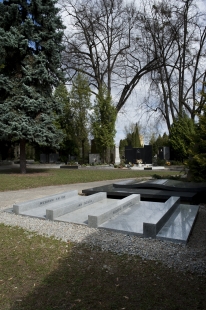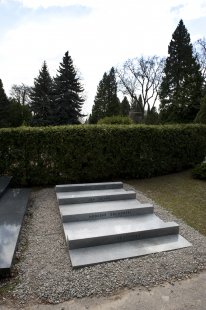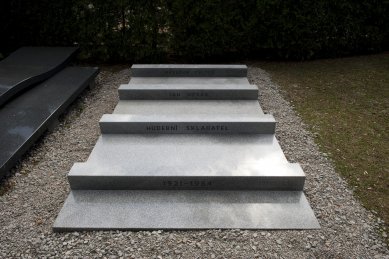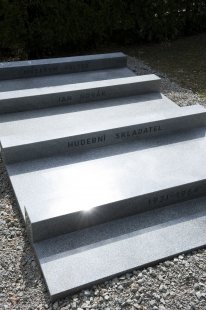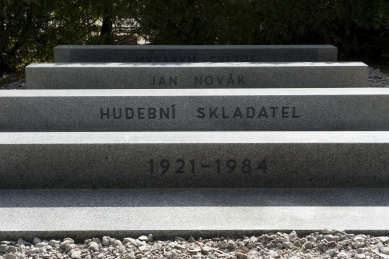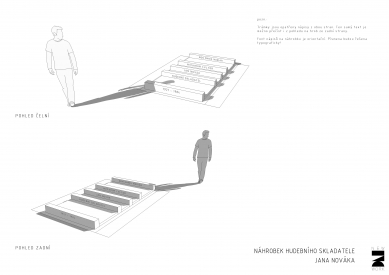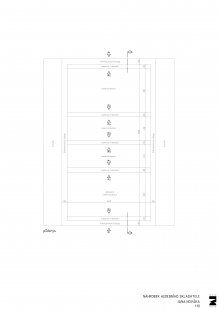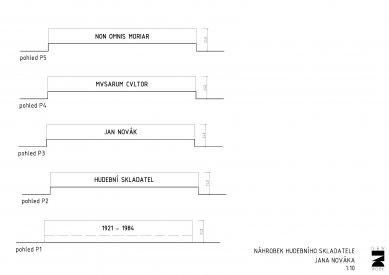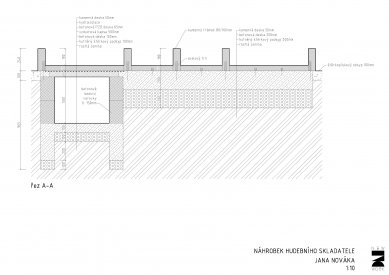
<TAG>Náhrobek hudebního skladatele Jana Nováka</TAG> translates to <TAG>Gravestone of the composer Jan Novák</TAG>

Jan Novák, an outstanding Czech composer of the 20th century, was long associated with the city of Brno. After graduating from the local classical gymnasium, he was admitted to the Brno Conservatory. During World War II, he was forced to work in Germany. In 1946, he graduated from the Brno Conservatory in the composition class of Professor Vilém Petrželka. He then received a scholarship that allowed him to study in the USA with Aaron Copland and Bohuslav Martinů. From 1948 to 1968, he lived in Brno as a freelance composer. During this time, notable works such as the ballet The Wedding Shirt, Concerto for Two Pianos, the song cycle Dulces cantilenae, and Ioci Vernales (Spring Jests) based on medieval texts were created. Novák also wrote stage music, including for Ludvík Kundera's play Total Rooster Crowing and film music for directors Karel Kachyňa and Jiří Trnka. The cantata Dido, based on Virgil's epic Aeneas, is considered the most significant work of his Brno period.
Jan Novák openly expressed his dissent against the ruling totalitarian regime, and his work was systematically silenced by official circles at home. After the occupation of Czechoslovakia in 1968, he emigrated with his entire family. He first lived for two years in Denmark, after which he moved for seven years to the northern Italian town of Riva near Rovereto. The third period of his life in exile was spent from 1978 in the German city of Ulm.
In Denmark, he composed the cantatas Ignis for Ioan Palach and Planctus Troadum as a response to the events in his native Czechoslovakia.
Italy was close to Novák as the cradle of Latin, which he read, wrote, and spoke. He also used Latin in most of his compositions. Here, the composer deepened his interest in studying Moravian folk song, which is evident in his works. Among other remarkable compositions, the opera Dulcitius was also created in Italy (performed in Brno in 1990).
Soon after arriving in Germany, he composed the significant work Ludi symphoniaci, which was performed by Rafael Kubelík with the Bavarian Radio Orchestra. Kubelík also contributed to the recording of the cantata Dido.
Despite a very fruitful period, during which a new compositional work was created every year, his works were completely ignored at home. This made the performances of his compositions abroad even more significant, where he is regarded as one of the most penetrating personalities of Czech music.
In 1986, the New York Philharmonic held a festival of Czech music, where the cantata Dido was performed under the direction of Martin Turnovský. Jan Novák did not live to see this performance. He died on November 17, 1984, at the age of 63. He was buried in Rovereto, Italy. His urn was transferred to Brno in the spring of 2011 and placed in a grave in the honorary burial site of the Central Cemetery in Brno.
The monument consists of four slabs and four granite beams of the same dimensions. On the vertical walls of the beams, there is a Latin inscription MVSARVM CVLTOR JAN NOVÁK 8.4.1921-17.11.1984 on both sides. The design of the monument begins and ends with half of the module of the granite slab. It appears the same from both sides, and the perspective gives the inscription the correct order.
Jan Novák openly expressed his dissent against the ruling totalitarian regime, and his work was systematically silenced by official circles at home. After the occupation of Czechoslovakia in 1968, he emigrated with his entire family. He first lived for two years in Denmark, after which he moved for seven years to the northern Italian town of Riva near Rovereto. The third period of his life in exile was spent from 1978 in the German city of Ulm.
In Denmark, he composed the cantatas Ignis for Ioan Palach and Planctus Troadum as a response to the events in his native Czechoslovakia.
Italy was close to Novák as the cradle of Latin, which he read, wrote, and spoke. He also used Latin in most of his compositions. Here, the composer deepened his interest in studying Moravian folk song, which is evident in his works. Among other remarkable compositions, the opera Dulcitius was also created in Italy (performed in Brno in 1990).
Soon after arriving in Germany, he composed the significant work Ludi symphoniaci, which was performed by Rafael Kubelík with the Bavarian Radio Orchestra. Kubelík also contributed to the recording of the cantata Dido.
Despite a very fruitful period, during which a new compositional work was created every year, his works were completely ignored at home. This made the performances of his compositions abroad even more significant, where he is regarded as one of the most penetrating personalities of Czech music.
In 1986, the New York Philharmonic held a festival of Czech music, where the cantata Dido was performed under the direction of Martin Turnovský. Jan Novák did not live to see this performance. He died on November 17, 1984, at the age of 63. He was buried in Rovereto, Italy. His urn was transferred to Brno in the spring of 2011 and placed in a grave in the honorary burial site of the Central Cemetery in Brno.
The monument consists of four slabs and four granite beams of the same dimensions. On the vertical walls of the beams, there is a Latin inscription MVSARVM CVLTOR JAN NOVÁK 8.4.1921-17.11.1984 on both sides. The design of the monument begins and ends with half of the module of the granite slab. It appears the same from both sides, and the perspective gives the inscription the correct order.
studio NEW WORK
The English translation is powered by AI tool. Switch to Czech to view the original text source.
0 comments
add comment


